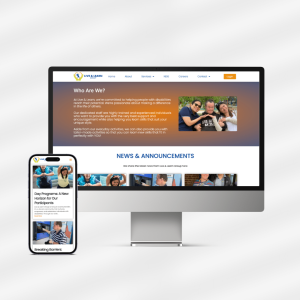In the competitive landscape of the National Disability Insurance Scheme (NDIS) sector, providing an accessible and user-friendly website is crucial for connecting with participants, their families, and carers. A well-designed website not only improves your online visibility but also enhances the user experience, leading to more referrals and a stronger reputation. At Mindsite Web Services, we specialise in creating websites for NDIS providers that are both engaging and accessible. Here are our top web design tips to enhance accessibility for your NDIS website:
1. Prioritise User-Friendly Navigation
- Clear Menu Structure: Organise your menu in a logical and straightforward manner. Use descriptive labels to help users quickly find the information they need.
- Breadcrumbs: Implement breadcrumb navigation to help users understand their location within the site and easily backtrack to previous pages.
2. Ensure Text is Readable
- Font Choice: Use clean, sans-serif fonts like Arial or Helvetica, which are easier to read on screens.
- Text Size: Ensure that your text is large enough to be easily read. A minimum of 16px is recommended for body text.
- Contrast: Maintain high contrast between text and background colours to improve readability for users with visual impairments.
3. Optimise for Screen Readers
- Alt Text for Images: Provide descriptive alt text for all images, ensuring that screen readers can convey the content and purpose of the images to visually impaired users.
- ARIA Landmarks: Use ARIA (Accessible Rich Internet Applications) landmarks to define regions of the page, helping screen reader users navigate more efficiently.
4. Design for Keyboard Navigation
- Tab Order: Ensure that the tab order follows the logical flow of the page. This allows users who navigate with a keyboard to move through the content in a coherent sequence.
- Focus Indicators: Use visible focus indicators to highlight interactive elements like links and buttons when they are selected using the keyboard.
5. Provide Accessible Forms
- Labels and Instructions: Clearly label all form fields and provide instructions or examples where necessary.
- Error Messages: Display error messages in a way that is easily noticeable and provide specific instructions on how to correct the error.
6. Incorporate Multimedia Accessibility
- Captions and Transcripts: Provide captions for videos and transcripts for audio content to ensure that all users can access the information.
- Descriptive Links: Use descriptive link text that clearly indicates the purpose or destination of the link, rather than vague terms like “click here.”
7. Test for Accessibility
- Accessibility Tools: Use tools like WAVE or Axe to test your website for accessibility issues. These tools can identify potential barriers and suggest improvements.
- User Testing: Conduct user testing with people who have disabilities to gather feedback on the accessibility and usability of your website.
8. Regular Updates and Maintenance
- Content Management: Keep your website content up to date and relevant. Regularly review and update information to ensure accuracy.
- Security and Performance: Perform regular updates to your website’s operating systems and applications to protect against security threats and improve performance.
Partner with Mindsite Web Services
At Mindsite Web Services, we understand the unique challenges faced by NDIS providers. Our team is dedicated to creating accessible and effective websites that meet the needs of all users. With our expertise in website design, SEO, content creation, and digital marketing, we can help you generate more participant referrals and enhance your online presence.
Enhance your NDIS website today! Get in touch with us for a free consultation and see how we can help you boost your online presence and generate more referrals and let us help you make a greater impact in the disability care sector.


